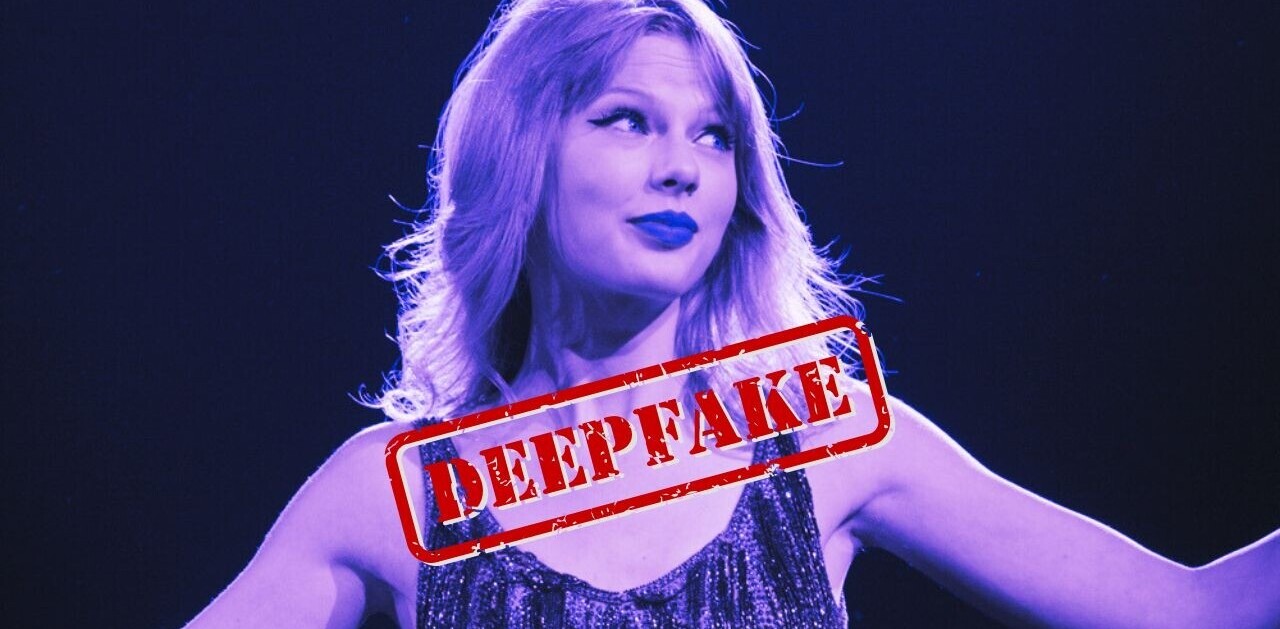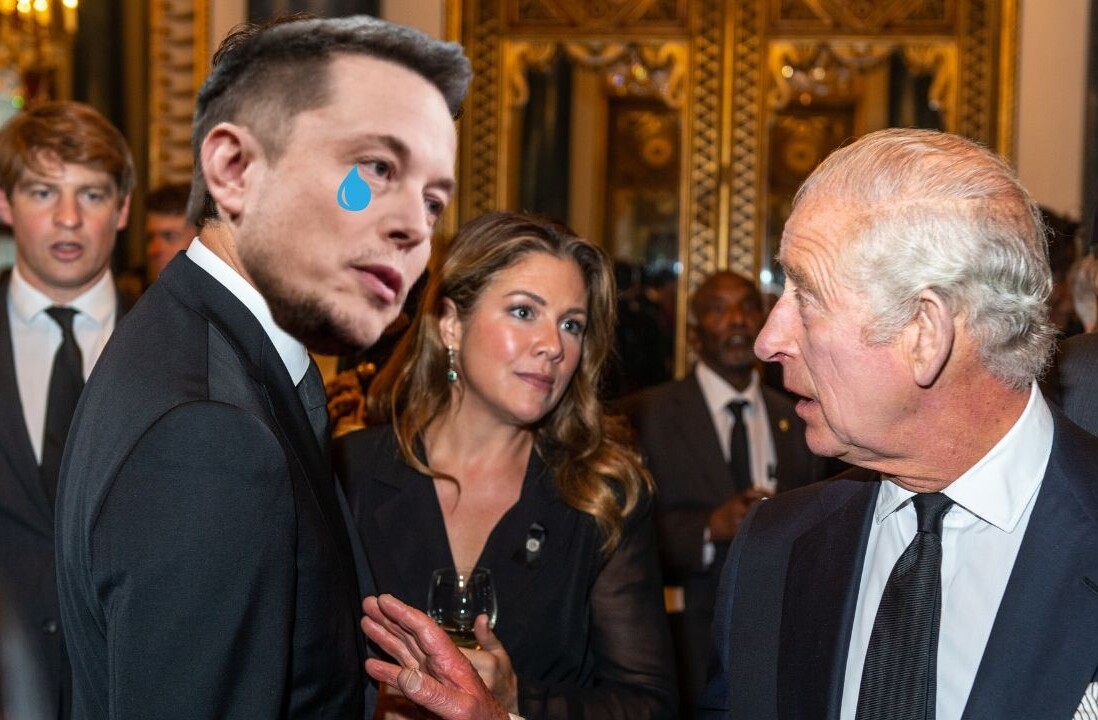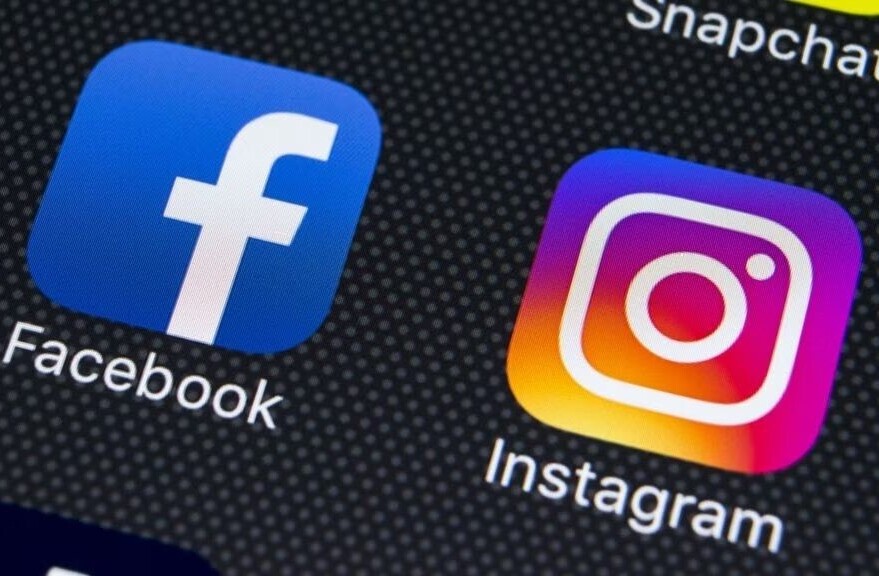![Clipboard may have just killed copy and paste [Invites]](https://img-cdn.tnwcdn.com/image?fit=1280%2C720&url=https%3A%2F%2Fcdn0.tnwcdn.com%2Fwp-content%2Fblogs.dir%2F1%2Ffiles%2F2011%2F10%2Fclippyheader.jpg&signature=464d5e76a8f8168af23eb96196e0afa0)
Copying and pasting is something we all do. Sometimes it’s for ourselves, but when we’re on the web we’re probably copying and pasting things to share with friends. Links, photos, and text get copied and pasted every day into emails, IM’s, Twitter, Facebook, and more.
Clipboard, a web app created by Gary Flake, previously founded Microsoft’s Live Labs, Yahoo Research, and Overture Research. It’s safe to say that Clipboard is built based on the needs of web surfers everywhere.
Instead of copying and pasting, Clipboard gives you a simple bookmarklet for your browser that will let you select a full element of a web page to save and share with whomever you like. It’s simple and seamless to do, and doesn’t feel as clunky as services who only save and share links like Delicious. You’re definitely going to want to sign up.
Here is a video from the company explaining Clipboard:
We talked with Clipboard’s founder Gary Flake about what makes Clipboard so different:
TNW: Please talk about your experience with Microsoft’s Live Labs, Yahoo Research, and Overture Research, and what you’ve learned about browser interaction on the web.
Gary Flake: In each of my three previous jobs I was hired to build teams that could create new opportunities, but outside of traditional structure and processes of the business. At Overture Research, we focused on low-level technology to help improve our overall economics (i.e., earn more money per search and per click). At Yahoo! Research, we tried to identify changes to existing products that could elicit an actual shift in the strategic landscape (e.g., make search less commercial or shift advertising to an options framework). And at Live Labs, we looked for new user experiences that could fundamentally change how people interacted with the Web (e.g., zoomable UIs).
In each case, browser interaction is absolutely fundamental to what you can and can’t do within any of these problem domains. For example, paid search works because the user’s intent in a query is a much stronger signal of intent than viewing a page. We also know that algorithmic Web search is complicated by the fact that users aren’t tolerant of having many more controls beyond a search box. Worse still, many users don’t have a clear mental model of what separates a browser from a Web page.
The most important lesson for me – and the one that is a bit humbling – is that understanding browser interaction is really, really hard. It’s hard because it touches on technology, business strategy, and user experiences, and you can’t even begin to understand the implications of these issues until you start thinking about all of these issues as different aspects of something more fundamental.
TNW: What in your experience told you that copying and pasting just wasn’t getting it done and needed innovation?
Gary Flake: The Web is over twenty years old and there is still no way to bring to together two search results from two different sources. The state-of-the-art for saving something from the Web is comically complicated: highlight content, hit CTRL/CMD-C, change into another application like an email or text editor, hit CTRL/CMD-V, hit save or send, then switch back to where you were when you started. Could this be any more complicated?
To add insult to injury, if you copy things in this way, you’ll usually end up with something that has little resemblance to the source, has lost some key functionality, and is hard to share.
What we really need is a way to save things that retains the visuals and functionality, but is also portable and shareable. The fact that nothing existed with all of these properties inspired me to create Clipboard.
TNW: Is Clipboard something that moms and dads and nongeeks are able to figure out? The worst part of sharing on the web for my parents is there are too many steps for them. Did you build this with those folks in mind?
Gary Flake: I think Clipboard can work for non-technologists and I absolutely had that sort of user in mind when I designed it. And for what it’s worth, my parents are regular Clipboard users today. The biggest hurdle has been to help people get the bookmarklet installed (what we call the “Clipper”). After that, it’s pretty easy because saving is as easy as two steps (launch then click).
We also default clips to be private instead of public because we have this sort of user in mind first and foremost.
To give you a little more context, before we came out of stealth mode, I sort of cryptically and cheekily described Clipboard as “social media with a purpose”. What I meant by that description is that a lot of services today (like social networks) work great for the tech savvy, but are leaving behind many others. With Clipboard, I am hoping to build something that appeals to those that are left behind by more typical social media. And to do that, we focused on the simplicity and utility of the experience above all else.
TNW: What other types of environments do you think Clipboard would work in, are there any mobile plans as of yet?
Gary Flake: Mobile will certainly need to be a priority for us in the not-too-distant future. We had to get the Web service solid first, but we’ll gradually start to increase the surface area of Clipboard in time.
Because copy/paste is such a ubiquitous need, I am especially interested in seeing how we can connect it not just to our own scenarios, but to those of other developers as well.
TNW: What sites do you personally clip from the most?
Gary Flake: As you can imagine, I clip a lot of stuff. For myself, I tend to clip things that I need to remember but would otherwise forget, such as the obscure technical tip form Hacker News or the Google search results that took me an hour of research to find.
My wife and I clip a lot of things that pertain to our home life, and this includes everything from shopping, stuff for the kids, ideas for activities, etc. Clipboard lets us share these clips privately, so we get something like a private workspace out of it. In truth, I think the top site that I clip from while in this mode is Amazon.
But the clips that I publish to the Clipboard feeds page are the things that I think others may like. This could be the occasional YouTube video or TED talk, but could also be something funny or weird that I saw on Reddit.
Taking a clip of a web page and sharing
When you grab a piece of a web page with Clipboard, you’re not taking a screenshot. You’re taking an actual element from a page and saving it. A perfect example is The Next Web’s Facebook page widget that you see on the right hand side of our pages.
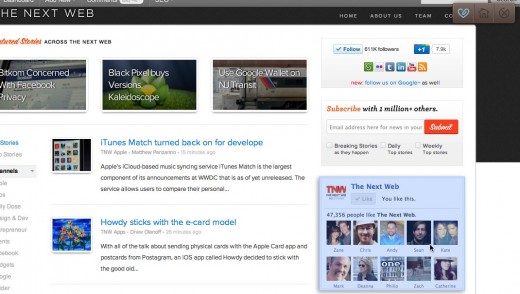
With Clipboard, you can just click a page element, and it is saved completely intact. All links work, and all images are in place.

After you’ve clipped an element with Clipboard, you can add tags, @ mentions, and any annotation that you like. At this time you can choose to publish your clip publicly or just save it to your own Clipboard dashboard. If you make your clip public, all of the hashtags and notes become searchable and discoverable by the rest of the Clipboard community.
This is a really smart design and service with a whole host of potential usages. If you see a great flash game, you can clip it and share it without having to copy and paste a link or embed it on your own site. If you’re a designer or developer and see a lightbox that you really like, you could share that with your team instantly using Clipboard. No view source and copy and paste needed.
Your Clipboard home and browsing clips
All of the clips you’ve taken using Clipboard are stored on a very well designed dashboard that you can view in tile or list format. Once you’ve taken and saved a clip, you can add annotations, switch it from private to public and vice versa, as well as share it via Facebook, Twitter, email, or an embed on your site or blog.
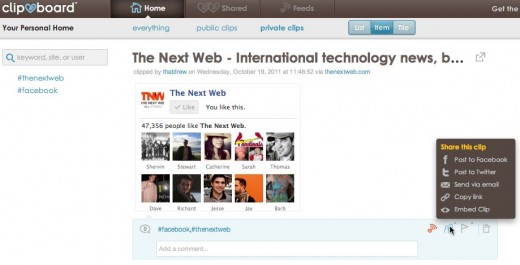
If you’d like to find elements found from around the web that others have shared, Clipboard makes it simple to do by searching for things you’re interested in. The keywords that you have used on your own clips are even stored for easy clicking and searching later.

You can sign up for Clipboard here to start clipping and sharing everything you see online.
Get the TNW newsletter
Get the most important tech news in your inbox each week.

